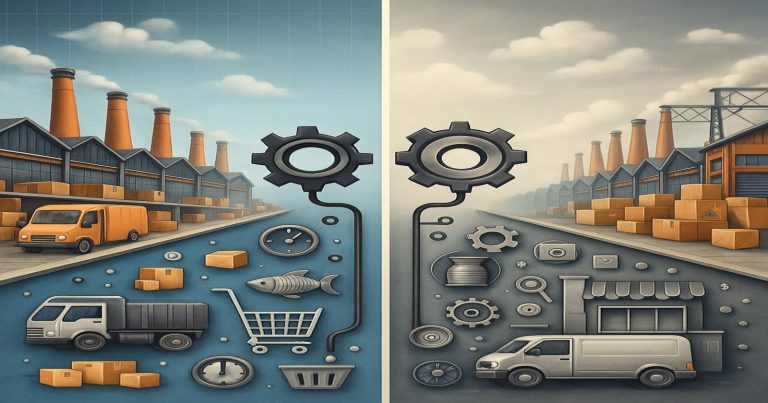Goods that are intermediate or final goods are important in comprehending transactions within economies, national income computations, and production processes. Final goods are those that are completely produced and are available for consumption or investment. Intermediate goods are products that are used as inputs into production in order to produce final goods. This is important to eliminate double-counting in GDP and assess the uses of goods in economic growth. This article will explore definitions, examples, distinctions, and the roles of final and intermediate goods.
Differences Between Final Goods and Intermediate Goods
The differences between final and intermediate goods are essential for understanding how products are used in economic production and how they are treated in economic data like GDP. The distinguishing differences revolve around their purpose, processing stage, the inclusion of GDP, demand type, and different examples. Knowing these differences could also help avoid double-counting GDP-wise, illuminate supply chains, and help policymakers make evidence-based decisions.
The detailed elaboration below will explain each distinguishing aspect involved:
| Aspect | Final Goods | Intermediate Goods |
| Purpose | Final goods are intended for end consumption or investment. Consumers or businesses purchase these goods for use without further transformation. | Intermediate goods are used as inputs in the production of other goods. Their purpose is to be transformed or incorporated into final goods. |
| Further Processing | These goods require no additional processing. They are complete and ready to be used by the final user. | These goods undergo further processing. They are part of a larger production chain and do not reach the consumer in their current form. |
| Inclusion in GDP | Final goods are counted in GDP because they reflect the final value of production in the economy. | Intermediate goods are excluded from GDP individually because their value is already included in the price of final goods. |
| Demand Type | Final goods have direct demand, meaning consumers or investors buy them directly to satisfy personal or business needs. | Intermediate goods have derived demand, meaning their demand depends on the demand for the final goods they help produce. |
| Examples | Examples include cars, clothing, appliances, and electronics—items that households or businesses purchase for direct use or capital investment. | Examples include steel, flour, cotton, wood, plastic, and other components used to produce cars, bread, clothes, furniture, and more. |
Expanded Explanation
- Purpose: A television purchased for a home is a final good. In contrast, the microchip inside it is an intermediate good because it is used to produce the television.
- Further Processing: A chair sold in a furniture showroom is a final good. The wood made is an intermediate good, as it underwent shaping, painting, and assembly before becoming the chair.
- Inclusion in GDP: Suppose a bakery buys flour to bake bread. The flour (intermediate good) is not counted in GDP separately. To avoid double-counting, only the final bread sold to consumers is included in GDP.
- Demand Type: A smartphone bought by a customer results from direct demand. However, the battery and screen used inside that smartphone have derived demand because they are needed only when there’s demand for the phone.
- Examples:
- Final Goods: Refrigerator, sofa, mobile phone.
- Intermediate Goods: Glass (used in windows), fabric (used in making clothes), sugar (used in sweets).
What are Final Goods and Intermediate Goods?
Final goods and intermediate goods represent two categories in the production process. Final goods are ready for end consumption or investment and require no further processing. The new thing about intermediate goods is that they are raw materials and conditions of production when producing final goods. Understanding these terms is a determinant in filling out the disparity between goods affecting the GDP and those driven indirectly through further processing, when referred to in this case. Certainly, it is meaningful to eliminate intermediate goods from the definition of final goods in economic terms.
Examples of Final and Intermediate Goods
Classifying a product as final or intermediate is paramount for economic calculations and understanding production cycles. This classification thus establishes the contrasting meaning of these two terms, intermediate goods and final goods, from the view of production and consumption.
- Final Goods: Cars, appliances, clothing, or any item sold directly to consumers.
- Intermediate Goods: Steel (used in car manufacturing), flour (used in baking), and cotton fabric (used in clothing).
Final Goods
Final goods are products that have reached the end of the production process and are ready for consumers or investment use. These goods do not require further processing; their value is included directly in a country’s Gross Domestic Product (GDP).
- Ready for Consumption or Investment: Final goods are either consumed by end-users or used as investments, such as machinery, which will produce other goods but is not processed further.
- No Further Processing Required: Final goods have completed the production process and are ready for the market, with no further changes necessary.
- Counted in GDP Calculations: Since final goods represent the total value of production, they are included in GDP calculations, while intermediate goods are excluded to avoid double-counting.
Examples of Final Goods
These examples support understanding the difference between final and intermediate goods in national income accounting.
- Consumer Goods: Products like electronics, food, clothing, and furniture that households buy are examples of final consumer goods.
- Capital Goods: Machinery, tools, and buildings used in production but not resold or further processed are classified as final goods for investment.
Final Goods Important Distinctions
Understanding important distinctions between final goods allows us to see how these goods affect economic indicators and fulfil market demands. Such distinctions highlight how critically final goods shape the course of economic policy and measure production.
Distinctions of Final Goods
These distinctions are essential when evaluating the difference between final and intermediate goods in economic planning.
- Consumption vs. Investment: Final goods can be further categorised into consumer goods (for immediate use) and capital goods (for investment purposes). Consumer goods satisfy immediate wants, while capital goods support future production.
- Durable vs. Non-Durable Goods: Final goods can also be categorised as durable (lasting over three years) or non-durable (used quickly). Examples include furniture (long-lasting) and food (non-durable).
- Role in GDP Calculation: Only final goods are counted in GDP calculations to reflect the economy’s actual production value, excluding intermediate goods to avoid overstating output.
- Impact on Economic Policies: Policymakers focus on final goods data to assess consumer spending and investment, influencing decisions on taxation, interest rates, and other economic policies.
Intermediate Goods
Intermediate goods are products used as inputs to produce final goods. These goods are not included in GDP calculations as separate items because their value is already embedded in the final products they help create. Intermediate goods are crucial to the production process, and their demand is derived from the demand for final goods.
- Used in Further Production: Intermediate goods undergo further processing to become part of final products or support the production of final goods, like raw materials and components.
- Excluded from GDP Calculations: To prevent double-counting, intermediate goods are not counted individually in GDP, as their value is already part of the final product.
- Dependent Demand: The demand for intermediate goods is driven by the demand for the final goods they help create, known as derived demand.
These points underline the difference between intermediate and final goods, especially in GDP accounting.
Examples of Intermediate Goods
Intermediate goods are essential to production but differ in economic measurements like GDP. This usage clearly explains the difference between intermediate and final goods regarding utility and value-added.
- Steel and Metal: Used in car manufacturing, construction, and other industries as a raw material.
- Sugar and Flour: Ingredients used in food production, such as baking bread or producing candies.
- Wood and Plastic: Materials used to make furniture, toys, or household goods.
Final Goods and Intermediate Goods FAQs
1. What is the difference between final goods and intermediate goods?
The difference between final goods and intermediate goods lies in their use. Final goods are for end consumption or investment, while intermediate goods are used in producing final goods.
2. What is the difference between intermediate goods and final goods in GDP?
The difference between intermediate and final goods in GDP is that only final goods are included to avoid double-counting. The intermediate goods’ value is already part of the final goods.
3. Can a good be both final and intermediate?
Yes, it depends on its use. For example, sugar sold to a household is a final good, but sugar sold to a bakery for making cakes is an intermediate good.
4. How do economists use the difference between intermediate and final goods?
Understanding the difference between intermediate and final goods helps economists accurately measure GDP and analyse consumption and production data.
5. What is the difference between final and intermediate goods, with examples?
The difference between final and intermediate goods is that final goods (e.g., TV, car) are ready for use, while intermediate goods (e.g., steel, cotton) are used to make final goods.


